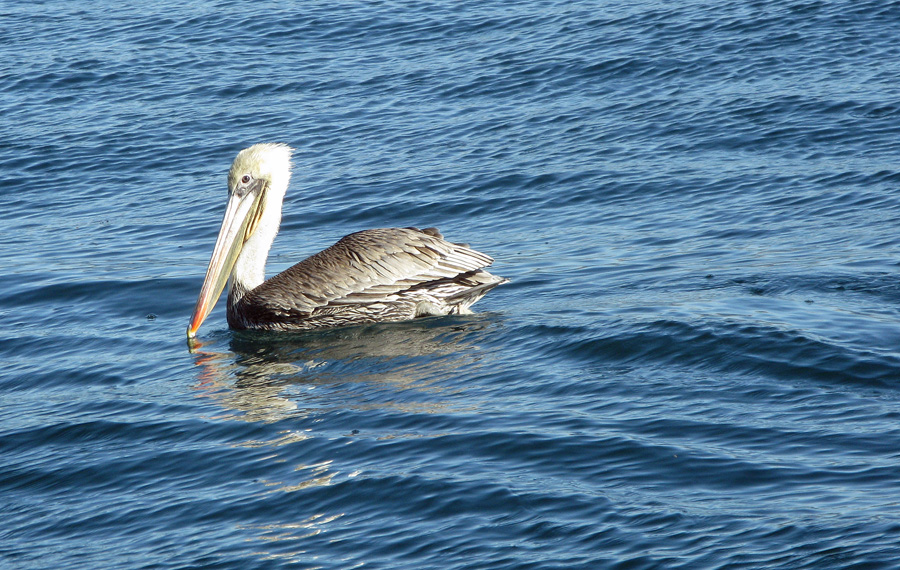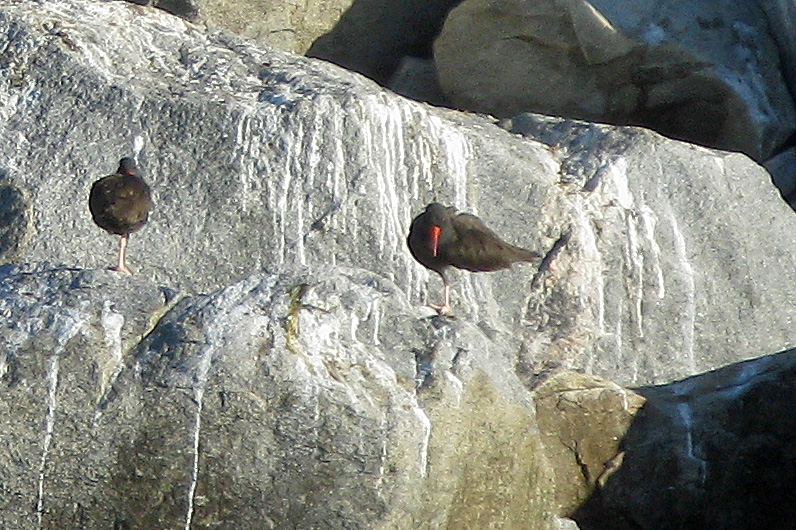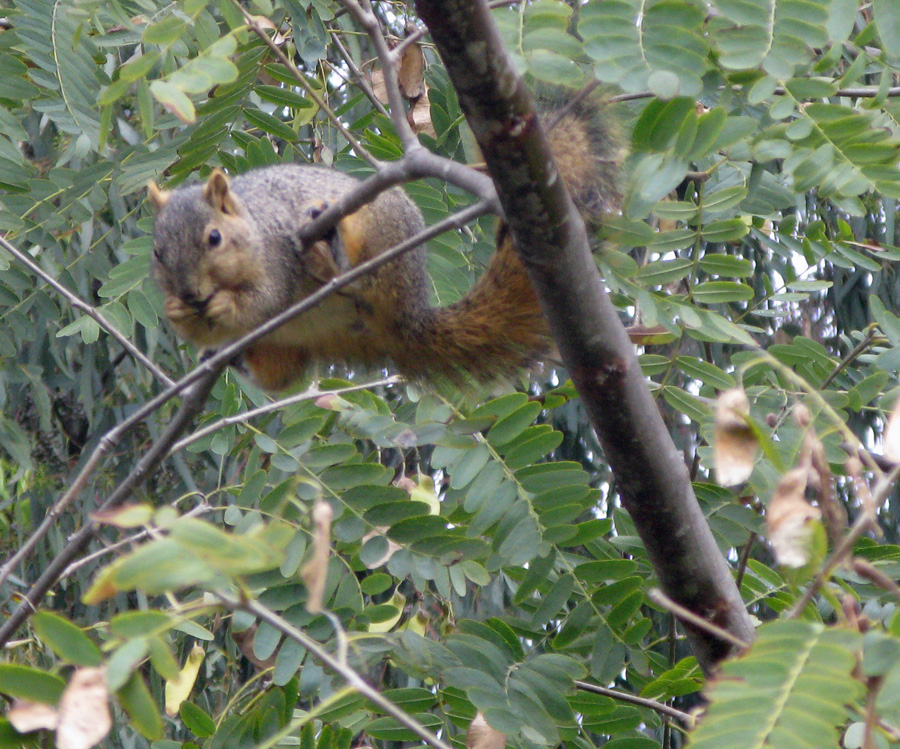Brown Pelican
January 13th, 2009
Off Dana Point, 2009-01-10

Off Dana Point, 2009-01-10
Saturday, January 10, I got up bright and early to catch the Ocean Institute’s Sea Explorer out of Dana Point that the Sea & Sage Audubon Society had chartered for a six-hour cruise starting at 8:00 A.M. The goal was just to see what we could find in Orange County Waters. January is a good month for pelagic birding in Orange County waters. Black-vented Shearwater is a lock, and lots of others are possible. According to the trip announcement, we might find “Rhinoceros Auklet, Xantus’ Murrelet, Cassin’s Auklet, Ancient Murrelet, Common Murre, Black-vented Shearwater, Pink-footed Shearwater, Sooty Shearwater, Northern Fulmar”. In fact, we got all but three of those. Weather wise alol you really hyave to worry about is fog, and it sure beats the hell out of January off Long Island.
The route was out a triangle. Steam from Dana Point about 14 miles out to the Sea Knoll, then north and inland to a point five miles out from Fashion Island where the sewer outflow pipe spews, then back to Dana Point.
Before we even got on the boat, the parking lot produced Rock Pigeon, American Crow, Red-tailed Hawk, Brewer’s Blackbird, House Finch, Allen’s Hummingbird, and Rock Pigeon. Before we left the harbor we had Double-crested Cormorant, Hermann’s Gull, Brown Pelican, Snowy Egret, Great Egret, Western Gull, and Ring-billed Gull. On the ocean side of the jetty we found four Black Oystercatchers and some peeps we never did identify. (Sanderlings? Western Sandpipers?)

(Yes, I know the photos are even worse than usual. You try taking pictures of fast moving birds far away from a rocking boat with a point-and-shoot camera.)
At first we mostly just saw more gulls and pelicans, but once we got a little ways offshore we picked up our first real pelagic bird: a Black-vented Shearwater, and my first life bird. Or it would have been if I hadn’t missed it completely. However a few minutes later three more flew by, and these I did get on. We would see many more throughout the day, and got much better looks at them.
Read the rest of this entry »
Put an illegible CAPTCHA on the support page:

Yes, spammers are so going to write bots to automate warranty checking, and this just has to be stopped.
In fact, it’s even worse than that. On the very next page, I have to type in the model and part number again, and solve another CAPTCHA.
Doesn’t really matter, I suppose. After the failure of the Maxtor OneTouch 4 I just bought a couple of months ago, it’s not like I was going to buy another Maxtor drive anyway.

Fox Squirrel, Sciurus niger
Huntington Central Park, 2009-01-03
Here’s one from the vaults. I found these in August, 2007, when these tent caterpillars were all over Jamaica Bay. However they weren’t ID’d until recently. This is the caterpillar of the Ailanthus Webworm Moth – Hodges 2401, Atteva punctella. In this case the moth is a lot prettier than the caterpillar:
A MacGillivray’s Warbler has been hanging out in Huntington Central Park near the Gothard Street parking lot for probably a month or more now. I have repeatedly tried to find it, and repeatedly come up empty. MacGillivray’s Warbler is one of my nemesis genus: the Oporornis. Its cousin the Connecticut Warbler (Oporornis agilis) eluded me for years. I still have never found a Mourning Warbler (Oporornis philadephia) or a Kentucky Warbler (Oporornis formosus). These birds all skulk around in the underbrush, and are very hard to locate.
However, others have found this particular individual, including on the recently completed Orange County Coastal Christmas Bird Count, and yesterday Sea & Sage was running a special trip to relocate as many of the rarities found on that count as we met up at the Slater Street parking lot a little before 8:00 A.M., discussed the various rarities found on the count, and planned out a plan of attack.
A White-throated Sparrow had been found in the immediate vicinity, but it probably moves around with a flock of the related White-crowned Sparrows, and one of those were in evidence at the moment. We pished a few bushes, but got nothing but a Towhee for our troubles, so we began walking slowly between the edge of the park and the island, toward the amphitheater, scanning the treetops for a Yellow-throated Vireo that’s also been hanging around for the last month or so. Yellow-rumped Warblers were abundant, and near the amphitheater I spotted our first Townsend’s warbler, but otherwise No luck, and after about an hour we turned back and began pishing our way back to the Slater Street parking lot.
However, this time we walked further up, alongside the Gothard Street parking lot as we passed it, we fanned out through the bushes. (There are a lot of “trails” in between the bushes because at different times of day, this is also a popular cruising area, much like the Ramble in that other Central Park back East.) By this point, birds other than yellow-rumps were beginning to wake up, and we found Orange-Crowned Warblers, Ruby-crowned Kinglets, Wilson’s Warblers, Bushtits, and finally in a bush? Could it be? No, it was a Song Sparrow.
But wait! What’s that that just skulked into that bush? Is it…? Nope. It’s a Common Yellowthroat. But then, as I’ve split off a little from the group and am scanning what i think has got to be my fifth Common Yellowthroat in the middle of a bush, I notice that:
By this point, the rest of the group that’s down on the sidewalk has also noticed the bird from the other side, and is gesturing wildly into the bush. Yep, it’s the MacGillivray’s. I never see more than about 3/4 of one side of the bird, for probably a minute as it hops around in the bush. Then it hops up from the bush into some overhanging vegetation and vanishes. No one can relocate it even though 20 people see exactly where it went. Oporornis are like this. Even when you see one, you don’t see it for long, and then they vanish while you blink. But that’s good enough for bird #455 and my first life bird of the year. No photo, I’m afraid. Finding these birds is difficult. Photographing one is nigh-on-impossible.
Read the rest of this entry »